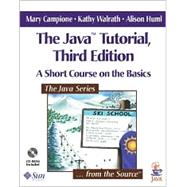
Mary Campione was formerly a senior technical writer at Sun Microsystems, where she started writing about the Java platform in 1995. Mary graduated from California Polytechnic, San Luis Obispo, with a B.S. in Computer Science and has worked as both a technical writer and programmer. Kathy Walrath is a senior technical writer on the Swing team at Sun Microsystems. After graduating from the University of California, Berkeley, with a B.S. in Electrical Engineering and Computer Science, Kathy wrote extensively about Unix, Mach, and NextStep. Since 1993, Kathy has been writing specifications and how-to guides for the Java platform.
Alison Huml is a technical writer at Sun Microsystems, where she joined The Java Tutorial team in 1997 and also works with the Security team. Alison received her B.A. in English from the University of California, Berkeley, and is currently pursuing her master's degree in Computer Science at Mills College.
| Preface | ix | ||||
|
1 | (44) | |||
|
2 | (5) | |||
|
7 | (1) | |||
|
8 | (8) | |||
|
16 | (8) | |||
|
24 | (8) | |||
|
32 | (9) | |||
|
41 | (2) | |||
|
43 | (2) | |||
|
45 | (20) | |||
|
46 | (2) | |||
|
48 | (1) | |||
|
49 | (3) | |||
|
52 | (2) | |||
|
54 | (1) | |||
|
55 | (6) | |||
|
61 | (1) | |||
|
62 | (1) | |||
|
63 | (2) | |||
|
65 | (54) | |||
|
67 | (9) | |||
|
76 | (18) | |||
|
94 | (5) | |||
|
99 | (18) | |||
|
117 | (2) | |||
|
119 | (58) | |||
|
120 | (12) | |||
|
132 | (17) | |||
|
149 | (16) | |||
|
165 | (9) | |||
|
174 | (3) | |||
|
177 | (50) | |||
|
178 | (26) | |||
|
204 | (14) | |||
|
218 | (6) | |||
|
224 | (3) | |||
|
227 | (16) | |||
|
228 | (6) | |||
|
234 | (8) | |||
|
242 | (1) | |||
|
243 | (26) | |||
|
244 | (1) | |||
|
245 | (1) | |||
|
246 | (9) | |||
|
255 | (1) | |||
|
255 | (5) | |||
|
260 | (1) | |||
|
260 | (5) | |||
|
265 | (1) | |||
|
266 | (2) | |||
|
268 | (1) | |||
|
269 | (44) | |||
|
271 | (2) | |||
|
273 | (4) | |||
|
277 | (4) | |||
|
281 | (5) | |||
|
286 | (5) | |||
|
291 | (10) | |||
|
301 | (6) | |||
|
307 | (2) | |||
|
309 | (1) | |||
|
310 | (3) | |||
|
313 | (38) | |||
|
314 | (4) | |||
|
318 | (16) | |||
|
334 | (6) | |||
|
340 | (5) | |||
|
345 | (1) | |||
|
346 | (1) | |||
|
346 | (2) | |||
|
348 | (3) | |||
|
351 | (40) | |||
|
352 | (1) | |||
|
353 | (3) | |||
|
356 | (5) | |||
|
361 | (3) | |||
|
364 | (4) | |||
|
368 | (7) | |||
|
375 | (3) | |||
|
378 | (3) | |||
|
381 | (6) | |||
|
387 | (1) | |||
|
388 | (2) | |||
|
390 | (1) | |||
| Appendix A Common Problems and Their Solutions | 391 | (16) | |||
|
391 | (5) | |||
|
396 | (1) | |||
|
397 | (2) | |||
|
399 | (8) | |||
| Appendix B Internet-Ready Applets | 407 | (60) | |||
|
409 | (10) | |||
|
419 | (4) | |||
|
423 | (19) | |||
|
442 | (12) | |||
|
454 | (3) | |||
|
457 | (6) | |||
|
463 | (4) | |||
| Appendix C Collections | 467 | (60) | |||
|
468 | (2) | |||
|
470 | (38) | |||
|
508 | (7) | |||
|
515 | (5) | |||
|
520 | (3) | |||
|
523 | (4) | |||
| Appendix D Deprecated Thread Methods | 527 | (8) | |||
|
527 | (3) | |||
|
530 | (3) | |||
|
533 | (1) | |||
|
534 | (1) | |||
| Appendix E Reference | 535 | (10) | |||
|
535 | (1) | |||
|
536 | (1) | |||
|
537 | (2) | |||
|
539 | (1) | |||
|
540 | (1) | |||
|
540 | (5) | |||
| Index | 545 |
The New copy of this book will include any supplemental materials advertised. Please check the title of the book to determine if it should include any access cards, study guides, lab manuals, CDs, etc.
The Used, Rental and eBook copies of this book are not guaranteed to include any supplemental materials. Typically, only the book itself is included. This is true even if the title states it includes any access cards, study guides, lab manuals, CDs, etc.